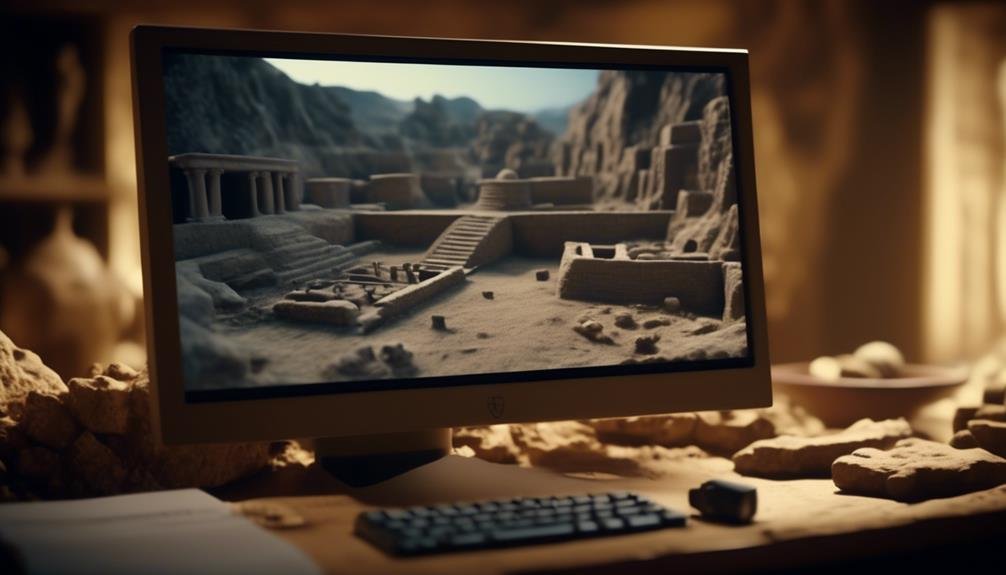Online Courses in Archaeology: Uncovering the Past
Embarking on an online course in archaeology is like peeling back the layers of time to reveal the secrets of our ancient ancestors. As you navigate through the virtual corridors of history, you'll uncover the tools, methods, and ethical considerations that shape the discipline.
But there's more to this digital journey than just exploring the past – it's about understanding how archaeology influences our present and shapes our future. Join me as we uncover the mysteries of the past and discover the relevance of archaeology in today's world.
Key Takeaways
- Online courses in archaeology provide access to education and learning about excavation techniques and artifact analysis.
- Advancements in technology, such as LiDAR and advanced imaging techniques, are revolutionizing site study by uncovering hidden structures and artifacts without invasive excavation.
- Preservation, conservation, and ethical considerations are essential in safeguarding cultural heritage for future generations.
- Archaeology offers diverse and rewarding career paths, with opportunities to contribute to our understanding of the past and engage in sustainable management of archaeological sites.
The Fascinating World of Archaeology
Explore the captivating world of archaeology and uncover the secrets of ancient civilizations. When it comes to fieldwork challenges, archaeologists face a myriad of obstacles, from harsh environmental conditions to logistical hurdles.
Excavation techniques have evolved over time, with modern technology playing a crucial role in uncovering and preserving artifacts. As you delve into this field, you'll gain a deeper appreciation for cultural heritage and indigenous perspectives. It's not just about digging up relics; it's about understanding the lives and traditions of those who came before us.
The fieldwork challenges you'll encounter will test your problem-solving skills and resilience, but the rewards of uncovering ancient secrets make it all worthwhile. By learning about excavation techniques, you'll develop a keen eye for detail and an understanding of the delicate process of unearthing history.
Embracing cultural heritage and indigenous perspectives will enrich your archaeological journey, providing a holistic view of the past and its significance in the present day.
Understanding Archaeological Methods
To understand archaeological methods, it is essential to grasp the various techniques employed in uncovering and interpreting historical artifacts and sites. Archaeological excavation is a fundamental method used to uncover artifacts and structures buried beneath the earth's surface. By carefully removing layers of soil and sediment, archaeologists can reveal and document the material remains of past human activities. Once artifacts and features are unearthed, the process of site interpretation begins. This involves analyzing the spatial distribution of artifacts and the stratigraphy of the site to understand the cultural significance and historical context. Additionally, various dating methods such as carbon-14 dating and dendrochronology are utilized to establish the chronology of the site. The following table provides an overview of common archaeological methods:
| Method | Description | Purpose |
|---|---|---|
| Archaeological Excavation | Systematic uncovering of artifacts and structures | Uncover material remains of past human activities |
| Site Interpretation | Analyzing spatial distribution of artifacts and features | Understand cultural significance and historical context |
| Dating Methods | Carbon-14 dating, dendrochronology, etc. | Establish the chronology of the site |
Understanding these methods is crucial for anyone interested in exploring the field of archaeology.
Exploring Ancient Civilizations
Unearthing the remnants of ancient civilizations provides a fascinating insight into the historical and cultural fabric of human societies. As you delve into the exploration of ancient civilizations, you'll uncover intriguing aspects such as:
- Ancient Trade Routes: Discover how ancient civilizations established trade routes that connected distant regions, shaping their economies and influencing cultural exchanges. Explore the significance of trade routes like the Silk Road, which facilitated the exchange of goods, technologies, and ideas between the East and West. Learn about the impact of trade routes on the development of civilizations, from the ancient Mesopotamians to the Han Dynasty in China.
- Cultural Exchange Patterns: Examine the patterns of cultural exchange between ancient civilizations, from the spread of religious beliefs to the diffusion of artistic styles. Understand how cultural interactions along trade routes led to the blending of traditions, languages, and customs, fostering cultural diversity and innovation. Investigate the influence of cultural exchange on the development of art, architecture, and societal norms across ancient civilizations.
Through these topics, you'll gain a deeper understanding of how ancient civilizations thrived and evolved through interconnected networks of trade and cultural exchange.
Unearthing Ancient Landscapes
You'll learn about geographic mapping techniques to uncover the ancient landscapes that once thrived.
Stratigraphy and dating methods will help you analyze the layers of history hidden beneath the surface.
Additionally, you'll explore remote sensing technologies to detect buried archaeological features from a distance.
Geographic Mapping Techniques
By employing advanced geographic mapping techniques, archaeologists can uncover the hidden landscapes of ancient civilizations, shedding light on their ways of life and interactions with the environment.
Geospatial analysis allows for the integration of various types of data to create detailed maps, revealing patterns and connections within ancient sites. This analysis aids in understanding the spatial relationships between different elements of ancient landscapes, such as settlements, agricultural areas, and ritual sites.
Site mapping techniques, including aerial surveys and LiDAR technology, provide a comprehensive view of ancient topography, enabling the identification of buried structures and features. These techniques help archaeologists locate potential excavation sites and plan targeted fieldwork to uncover artifacts and architectural remains.
The application of Geographic Information Systems (GIS) facilitates the visualization and analysis of spatial data, offering valuable insights into the organization and layout of ancient settlements and landscapes.
Stratigraphy and Dating
Exploring ancient landscapes through the study of stratigraphy and dating provides valuable insights into the historical timelines of civilizations. Relative dating allows archaeologists to determine the age of artifacts and features in comparison to other objects, providing a sequence of events without pinpointing an exact date. This method relies on the analysis of layers of sediment and the principle of superposition.
On the other hand, absolute dating techniques such as radiocarbon dating and dendrochronology provide specific chronological dates for artifacts and sites. These methods are crucial for understanding the temporal aspects of human history and the development of societies.
Remote Sensing Technologies
Uncovering ancient landscapes through the application of remote sensing technologies allows for a deeper understanding of the historical timelines of civilizations, complementing the insights gained from stratigraphy and dating methods. When it comes to remote sensing applications at archaeological sites, there are several fascinating aspects to consider:
- Aerial Survey: Remote sensing technologies such as LiDAR and aerial photography enable archaeologists to detect subtle variations in terrain, revealing hidden features that aren't visible from the ground.
- Archaeological Exploration: Through the use of ground-penetrating radar and satellite imagery, archaeologists can identify potential excavation sites and map out ancient structures without the need for extensive physical excavation.
- Data Analysis: Remote sensing technologies provide vast amounts of data, which can be analyzed using geographic information systems (GIS) to create detailed maps and 3D models of archaeological sites, aiding in the interpretation of past landscapes.
Interpreting Archaeological Artifacts
When interpreting archaeological artifacts, you'll learn about various methods employed. Understanding artifact interpretation methods will enable you to glean insights into the lives of people in the past. This knowledge will help you piece together the intricate puzzle of human history through the lens of material culture.
You will also learn about the significance of these artifacts and how they contribute to understanding historical contexts. By studying artifacts, you can uncover information about past societies, their beliefs, practices, and interactions. These artifacts provide tangible evidence that helps historians and archaeologists reconstruct the past.
Artifact Interpretation Methods
Understanding the significance of archaeological artifacts requires employing various interpretation methods that shed light on the material culture of past societies.
When it comes to artifact analysis, examining the physical properties, such as composition and craftsmanship, can provide clues about the technological capabilities of ancient civilizations.
Additionally, understanding the cultural context in which the artifact was created is crucial for interpreting its significance within the society.
Exploring the spatial distribution of artifacts within a site can reveal patterns of usage or social hierarchies.
Furthermore, considering the symbolic or ritualistic meanings associated with certain artifacts can offer insights into the belief systems and practices of the past society.
Significance of Artifacts
By employing various interpretation methods, you can uncover the significance of archaeological artifacts and gain insights into the material culture of past societies. Understanding the significance of artifacts involves considering their preservation and cultural importance. Artifact preservation is crucial in maintaining the integrity of the historical record. Through proper documentation, storage, and conservation, artifacts can be protected for future study and appreciation. Additionally, artifacts hold cultural significance as they offer invaluable clues about the beliefs, practices, and daily lives of ancient societies. They provide a tangible link to the past, allowing us to piece together the puzzle of human history. By studying these objects, you can unravel the stories of ancient civilizations and comprehend the complexities of human existence throughout time.
| Artifact Preservation | Cultural Significance |
|---|---|
| Proper documentation and storage | Insight into beliefs and practices |
| Conservation efforts | Understanding daily lives |
| Protection for future study | Connecting to ancient civilizations |
Historical Context Understanding
Interpreting archaeological artifacts involves analyzing their historical context to reveal insights into the lives and cultures of past societies. When delving into historical context analysis and interpretation, consider the following:
- Provenance: Investigate the artifact's origin, including its geographical location and the specific archaeological site where it was found. This can offer valuable clues about the artifact's historical significance and its connections to the surrounding environment.
- Chronological Placement: Understanding the artifact's temporal placement within a historical timeline is crucial for interpreting its cultural relevance and technological advancements within a specific time period.
- Cultural Preservation: Explore the ethical considerations and practices involved in preserving and protecting cultural heritage, including the responsible management of archaeological sites and the conservation of artifacts for future generations. Understanding these aspects is vital for maintaining the integrity of historical contexts.
The Role of Technology in Archaeology
Archaeology relies heavily on technological advancements to aid in the discovery and analysis of historical artifacts and sites. The integration of technology has significantly transformed archaeological fieldwork, allowing for more precise and efficient data collection, analysis, and preservation of historical findings. Digital documentation, in particular, has revolutionized the way archaeological discoveries are recorded and studied, providing a more comprehensive and accessible means of preserving and sharing historical information.
| Advantages of Technology in Archaeology | Examples |
|---|---|
| Enhanced data collection and analysis | 3D laser scanning for site mapping and artifact preservation |
| Improved site preservation | Drone technology for aerial surveys and site monitoring |
| Accessible historical information | Virtual reality for immersive exploration of historical sites |
| Collaborative research opportunities | Online databases and research platforms for global collaboration |
These technological advancements not only facilitate the exploration and understanding of the past but also open up new possibilities for collaboration and engagement in the field of archaeology. By embracing and integrating these technological tools, archaeologists can continue to uncover and preserve our rich historical heritage for future generations.
Preservation and Conservation Techniques
You'll learn about techniques to prevent material deterioration, such as proper storage and environmental impact assessment.
These preservation and conservation methods will help safeguard artifacts for future generations.
Material Deterioration Prevention
How can archaeological materials be effectively preserved and conserved to prevent deterioration over time? Implementing preventive conservation measures and material decay management techniques is crucial for safeguarding archaeological artifacts. Here's what you need to know:
- Environmental Monitoring: Learn about the significance of monitoring and controlling environmental conditions to prevent material decay.
- Conservation Treatments: Explore the various conservation treatments used to stabilize and protect archaeological materials from further deterioration.
- Integrated Pest Management: Discover how integrated pest management strategies can effectively combat pest infestations, safeguarding artifacts from irreversible damage.
Understanding these preventive conservation methods and material decay management approaches is essential for preserving archaeological materials and ensuring their longevity for future study and appreciation.
Artifact Storage Methods
To ensure the long-term preservation of archaeological artifacts, employing effective artifact storage methods is essential. Artifact preservation and conservation are crucial to maintaining the integrity of these historical items. Proper artifact documentation and cataloging also play a significant role in ensuring that these artifacts are appropriately stored and easily accessible for research and exhibition purposes. Here's a helpful table outlining some common artifact storage methods:
| Storage Method | Description |
|---|---|
| Acid-free boxes | Prevents acid migration that can damage artifacts |
| Climate-controlled | Maintains stable temperature and humidity levels |
| Shelving systems | Provides organized and accessible storage |
Environmental Impact Assessment
Employing environmental impact assessment techniques is essential for ensuring the preservation and conservation of archaeological artifacts. When evaluating the environmental impact, it's crucial to consider the potential harm to cultural heritage, such as the disturbance of archaeological sites or the destruction of historical landscapes.
Conservation methods play a vital role in mitigating these impacts, including the use of non-invasive survey techniques to assess the site's condition without causing damage. Implementing sustainable conservation practices is key to safeguarding archaeological sites for future generations, encompassing strategies like controlled excavation to minimize disturbance and the use of eco-friendly preservation materials.
Ethical Considerations in Archaeology
Considering ethical principles is essential in the practice of archaeology to ensure the proper treatment of cultural heritage and respect for local communities. As an archaeologist, understanding the significance of cultural heritage is crucial. It involves recognizing and preserving the material remains of past human activities, artifacts, and sites. It's not just about the physical objects themselves, but also the stories, traditions, and knowledge they embody.
When engaging with cultural heritage, it's important to approach it with sensitivity and understanding, acknowledging its value to the communities to which it belongs. Community engagement is another vital aspect of ethical archaeology. It involves collaborating with local communities, seeking their input, and respecting their perspectives. These interactions foster mutual respect and understanding, ensuring that archaeological work is conducted in a manner that aligns with the interests and values of the communities involved.
Career Opportunities in Archaeology
Interested in pursuing a career in archaeology? There are various exciting opportunities awaiting you in this field. Here are some key areas to consider:
- Fieldwork Opportunities
Archaeologists often have the chance to work on archaeological digs, excavating and analyzing artifacts in the field. This hands-on experience allows you to uncover history firsthand and contribute to our understanding of the past.
- Museum Curation
Many archaeologists find fulfilling careers in museum curation, where they get to manage and interpret collections of historical artifacts. This role allows you to engage with the public, share knowledge, and preserve cultural heritage for future generations.
- Cultural Resource Management
In this sector, archaeologists work to assess and preserve archaeological sites impacted by development projects. It involves navigating the intersection of cultural heritage and modern development, ensuring that important historical sites are protected.
These career paths offer diverse and rewarding opportunities for those passionate about uncovering the mysteries of the past. Whether you're drawn to hands-on fieldwork, the educational aspect of museum curation, or the preservation of cultural resources, a career in archaeology can be an enriching and impactful choice.
The Future of Archaeological Research
Looking ahead, the future of archaeological research holds exciting prospects for uncovering new insights into the ancient world. With the rapid advancements in technology, archaeological data analysis is expected to become more sophisticated, allowing researchers to extract deeper insights from existing data and uncover new details about past civilizations.
Future technologies like LiDAR (Light Detection and Ranging) and advanced imaging techniques are poised to revolutionize the way archaeological sites are studied, potentially revealing hidden structures and artifacts without the need for invasive excavation.
Furthermore, the future of archaeological research will also prioritize cultural heritage preservation and community engagement. As the significance of preserving cultural heritage becomes increasingly recognized, archaeologists will work closely with local communities and indigenous groups to ensure that their heritage is respected and protected.
This collaborative approach not only fosters a deeper understanding of the past but also promotes the sustainable management of archaeological sites for future generations.
Conclusion
Congratulations on completing your journey through the fascinating world of archaeology!
Now that you've uncovered the past, remember that just like an ancient artifact, you hold valuable knowledge and insights.
Keep exploring, digging deeper, and preserving the stories of our ancestors.
Your journey in archaeology is only just beginning, and the future holds endless opportunities for discovery and research.
Keep digging, and never stop uncovering the hidden treasures of our past.







